4 Lab 4—Geologic timescales, stratigraphy, and dating rocks
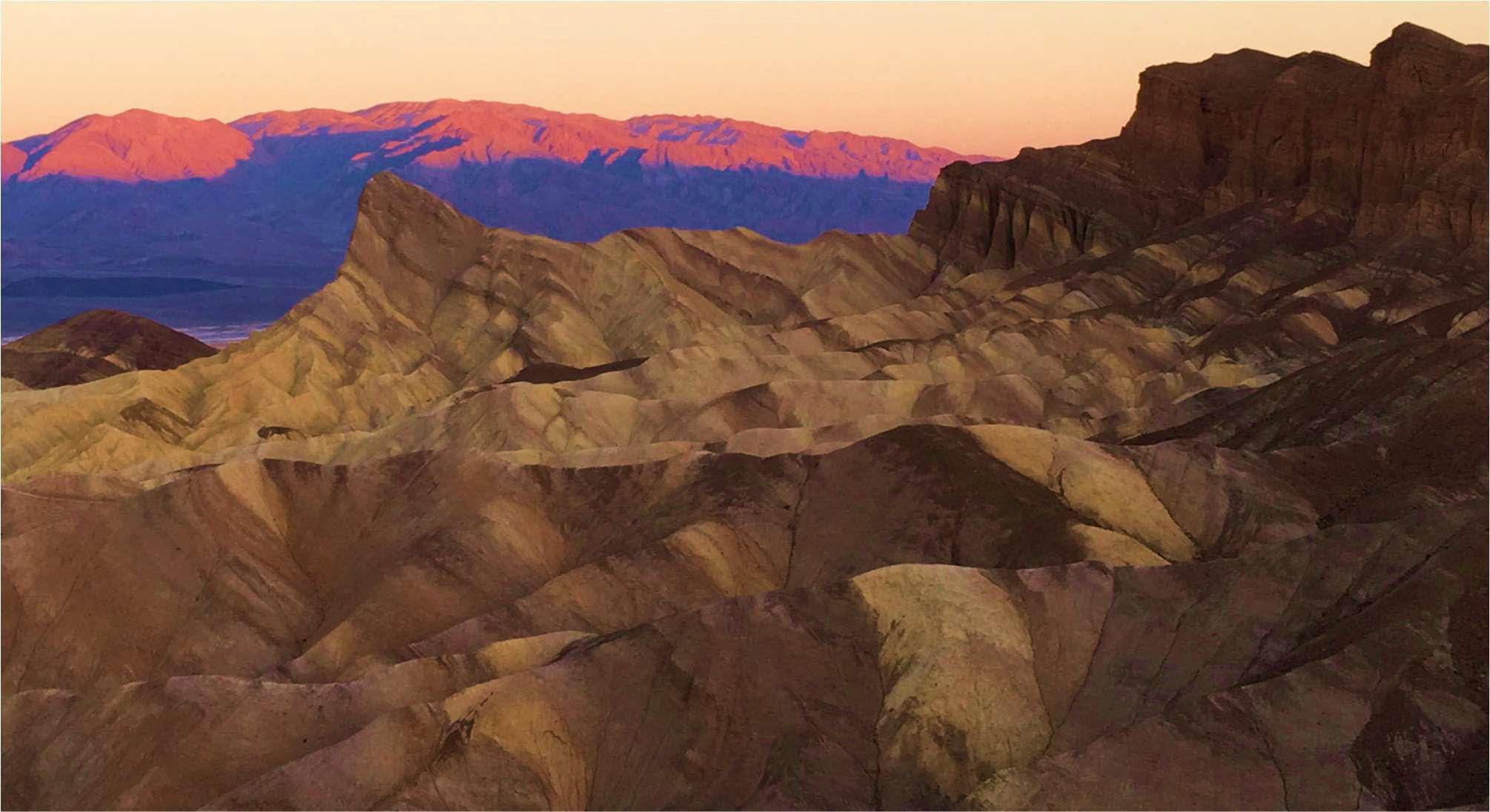
Figure 4.1 Zabriskie Point, Death Valley National Park (Bosch, 2017)
AGE OF THE EARTH
The following text was adopted from the United States Geological Survey webpage, “Age of the Earth” (2007).
“So far scientists have not found a way to determine the exact age of the Earth directly from Earth rocks because Earth’s oldest rocks have been recycled and destroyed by the process of plate tectonics. If there are any of Earth’s primordial rocks left in their original state, they have not yet been found. Nevertheless, scientists have been able to determine the probable age of the Solar System and to calculate an age for the Earth by assuming that the Earth and the rest of the solid bodies in the Solar System formed at the same time and are, therefore, of the same age.
“The ages of Earth and Moon rocks and of meteorites are measured by the decay of long- lived radioactive isotopes of elements that occur naturally in rocks and minerals and that decay with half lives of 700 million to more than 100 billion years to stable isotopes of other elements.
“These dating techniques, which are firmly grounded in physics and are known collectively as radiometric dating, are used to measure the last time that the rock being dated was either melted or disturbed sufficiently to rehomogenize its radioactive elements.
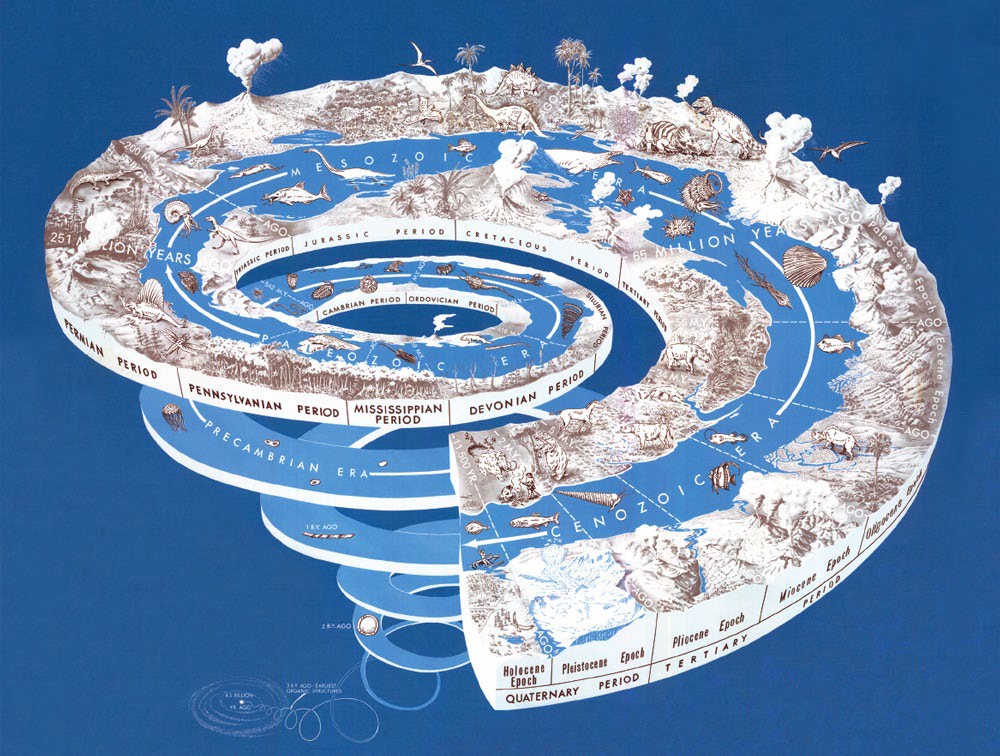
Figure 4.2 Spiral representation of the age of the earth (USGS, 2008)
“Ancient rocks exceeding 3.5 billion years in age are found on all of Earth’s continents. The oldest rocks on Earth found so far are the Acasta Gneisses in northwestern Canada near Great Slave Lake (4.03 Ga) and the Isua Supracrustal rocks in West Greenland (3.7 to 3.8 Ga), but well-studied rocks nearly as old are also found in the Minnesota River Valley and northern Michigan (3.5-3.7 billion years), in Swaziland (3.4-3.5 billion years), and in Western Australia (3.4-3.6 billion years). These ancient rocks have been dated by a number of radiometric dating methods and the consistency of the results give scientists confidence that the ages are correct to within a few percent. An interesting feature of these ancient rocks is that they are not from any sort of “primordial crust” but are lava flows and sediments deposited in shallow water, an indication that Earth history began well before these rocks were deposited. In Western Australia, single zircon crystals found in younger sedimentary rocks have radiometric ages of as much as 4.3 billion years, making these tiny crystals the oldest materials to be found on Earth so far. The source rocks for these zircon crystals have not yet been found. The ages measured for Earth’s oldest rocks and oldest crystals show that the Earth is at least 4.3 billion years in age but do not reveal the exact age of Earth’s formation. The best age for the Earth (4.54 Ga) is based on old, presumed single-stage leads coupled with the Pb ratios in troilite from iron meteorites, specifically the Canyon Diablo meteorite. In addition, mineral grains (zircon) with U-Pb ages of 4.3 Ga have recently been reported from sedimentary rocks in west-central Australia.
“The Moon is more primitive than Earth because it has not been disturbed by plate tectonics; thus, some of its more ancient rocks are more plentiful. Only a small number of rocks were returned to Earth by the six Apollo and three Luna missions. These rocks vary greatly in age, a reflection of their different ages of formation and their subsequent histories. The oldest dated moon rocks, however, have ages between 4.4 and 4.5 billion years and provide a minimum age for the formation of our nearest planetary neighbor. Thousands of meteorites, which are fragments of asteroids that fall to Earth, have been recovered. These primitive objects provide the best ages for the time of formation of the Solar System. There are more than 70 meteorites, of different types, whose ages have been measured using radiometric dating techniques. The results show that the meteorites, and therefore the Solar System, formed between 4.53 and 4.58 billion years ago. The best age for the Earth comes not from dating individual rocks but by considering the Earth and meteorites as part of the same evolving system in which the isotopic composition of lead, specifically the ratio of lead-207 to lead-206 changes over time owing to the decay of radioactive uranium-235 and uranium-238, respectively. Scientists have used this approach to determine the time required for the isotopes in the Earth’s oldest lead ores, of which there are only a few, to evolve from its primordial composition, as measured in uranium-free phases of iron meteorites, to its compositions at the time these lead ores separated from their mantle reservoirs. These calculations result in an age for the Earth and meteorites, and hence the Solar System, of 4.54 billion years with an uncertainty of less than 1 percent. To be precise, this age represents the last time that lead isotopes were homogeneous throughout the inner Solar System and the time that lead and uranium was incorporated into the solid bodies of the Solar System.
“The age of 4.54 billion years found for the Solar System and Earth is consistent with current calculations of 11 to 13 billion years for the age of the Milky Way Galaxy (based on the stage of evolution of globular cluster stars) and the age of 10 to 15 billion years for the age of the Universe (based on the recession of distant galaxies).”
“For additional information on this subject, see G. Brent Dalrymple’s The Age of the Earth, published by the Stanford University Press (Stanford, Calif.) in 1991 (492 p.)”
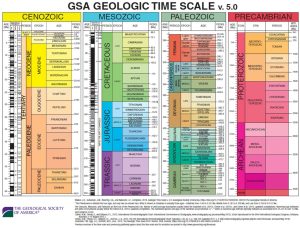 Figure 4.3 Geological Time Scale
Figure 4.3 Geological Time Scale
PRINCIPLES OF STRATIGRAPHY
These principles for relative dating of rock strata were first developed by Danish geological pioneer Nicholas Steno in Dissertationis prodromus (1669) and later formulated by James Hutton in Theory of the Earth (1795) and embellished upon by Charles Lyell in Principles of Geology (1830). This resulted in the following seven principles to guide relative dating of geologic units.
Superposition
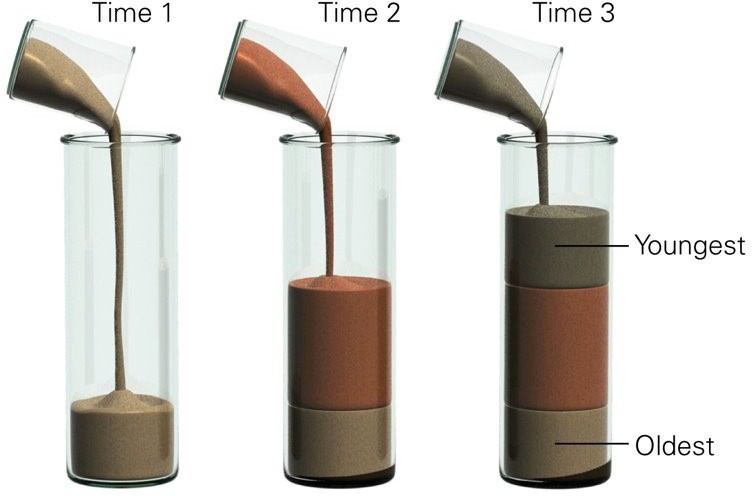
In undeformed stratigraphic sequences, the oldest strata will lie at the bottom of the sequence, while newer material stacks upon the surface to form new deposits over time.
Original horizontality
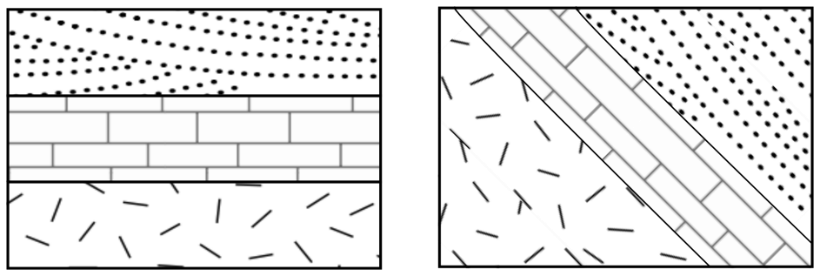
Layers of sediment are originally deposited horizontally under the action of gravity. Therefore, rocks that are titled at an angle must have been deformed from their original position.
Lateral continuity
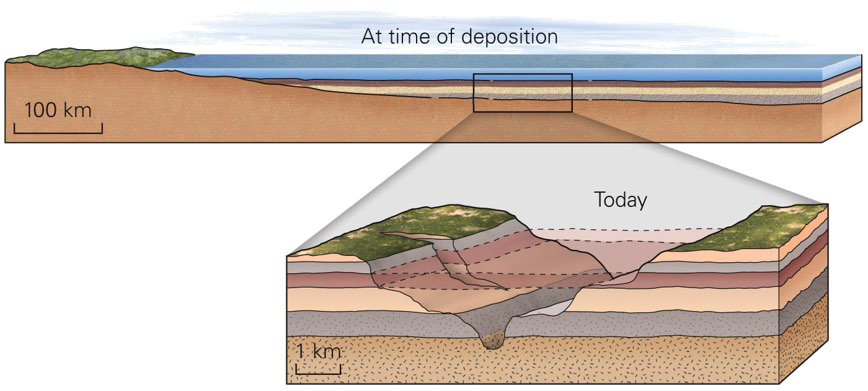
Layers of sediment initially extend laterally in all directions; in other words, they are laterally continuous. As a result, rocks that are otherwise similar, but are now separated by a valley or other erosional feature, can be assumed to be originally continuous.
Cross-cutting relationships
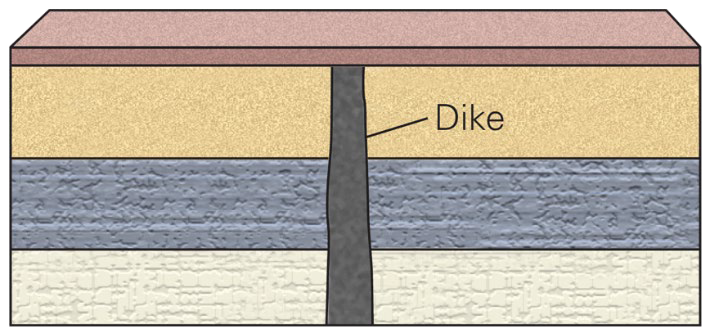
The geologic feature which cuts another is the younger of the two features. In this example, the dike is younger than the three lowermost layers.
Inclusions
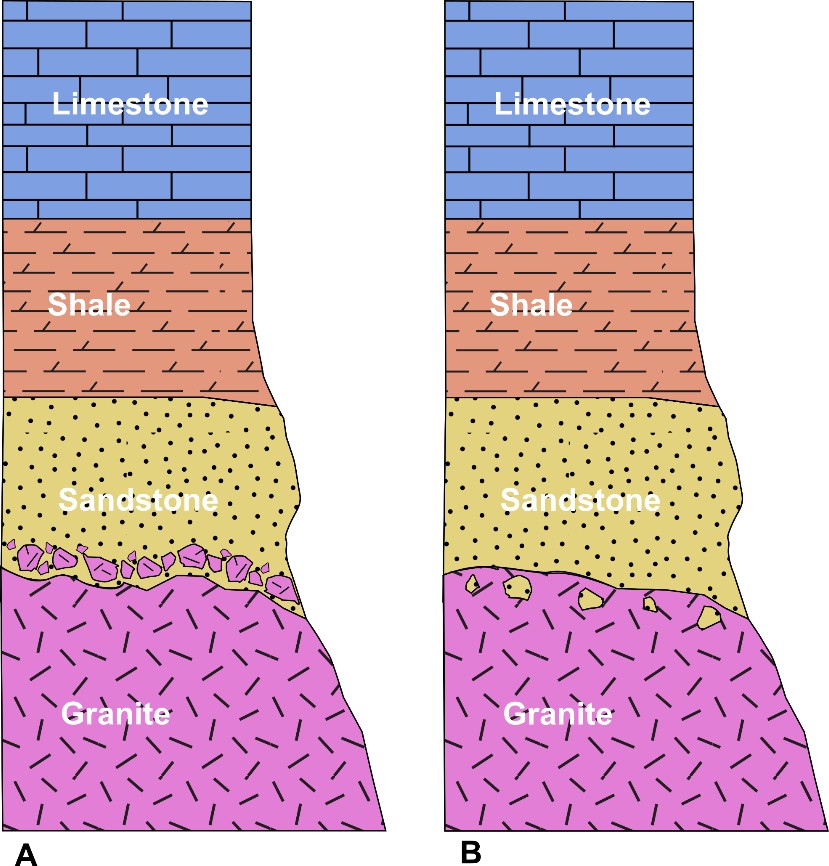
Clasts included in a rock are older than the rock, itself. In A on the left, the granite inclusions indicate that the granite is older than the sandstone, and that the sandstone was deposited on top of the granite, eroding pieces of granite off to include in the sandstone. In B on the right, the sandstone inclusions indicate that the sandstone is older than the granite, and therefore the granite was intruded into the sandstone.
Unconformities
A gap of time that is not represented in the rock record can result from an erosional event or a period of non-deposition. There are three types of unconformities:
Angular unconformity
An angular unconformity is an unconformity where horizontally parallel strata of sedimentary rock are deposited on tilted and eroded layers, producing an angular discordance with the overlying horizontal layers.

Nonconformity
A nonconformity exists between sedimentary rocks and metamorphic or igneous rocks when the sedimentary rock lies above and was deposited on the pre-existing and eroded metamorphic or igneous rock.

Disconformity
A disconformity is an unconformity between parallel layers of sedimentary rocks which represents a period of erosion or non-deposition.

Fossil succession
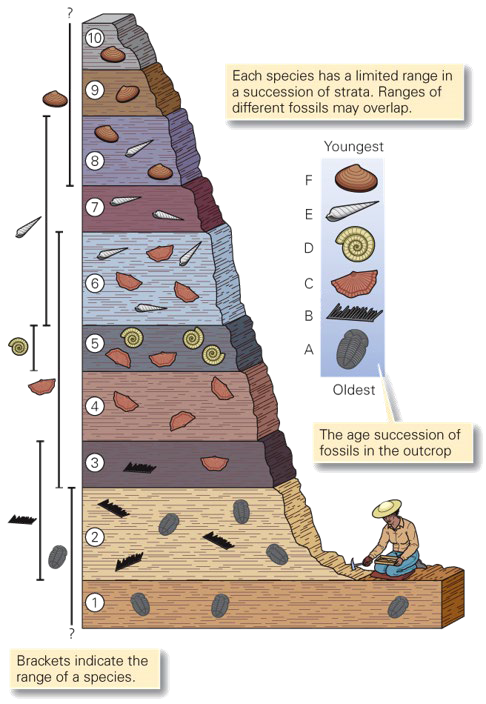
Sedimentary rock strata contain fossilized flora and fauna. These fossils succeed each other vertically in a specific, reliable order that can be identified over wide horizontal distances.
WHAT ARE STRATIGRAPHIC COLUMNS?
Stratigraphic columns are the traditional means of presenting measured geologic sequences as a figure. Information should be arranged with the youngest rock unit at the top and the oldest rock unit at the bottom. The column should consist of small boxes containing the symbol used
on the map to identify the rock unit, and if the map is colored or if patterns are used, they should also appear in the box. The name of the rock unit is written adjacent to the box. Brief descriptions of the units may be lettered to the right of the column, as in the figure, or thecolumn may be accompanied by an explanation consisting of a small box for each lithologic symbol and
for the other symbols alongside the column. Columns are constructed from the stratigraphic base upward and should be plotted first in pencil in order to insure spaces for gaps at faults and unconformities. Sections that are thicker than the height of the plate can be broken into two or more segments, with the stratigraphic base at the lower left and the top at the upper right. Bedding and unit boundaries are drawn horizontally, except in detailed sections or generalized sections of distinctly nontabular deposits, some gravels, and volcanic units.
The following elements of a stratigraphic column are essential and are generally keyed to the figure:

- title, indicating topic, general location, and whether the section is single (measured in one coherent course), composite (pieced from two or more section segments), averaged, or generalized;
- name(s) of geologist(s) and date of the survey;
- method of measurement;
- graphic scale;
- map or description of locality;
- major chronostratigraphic units, if known;
- lesser chronostratigraphic units, if known;
- names and boundaries of rock units;
- graphic column composed of standard lithologic patterns;
- unconformities;
- faults, with thick ness of tectonic gaps, if known;
- covered intervals, as measured,
- positions of key beds; and
- positions of important samples with number and perhaps data. Other kinds of information may be included also. (Link et al., 2019)
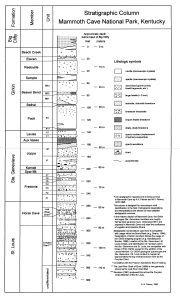
Figure 4.5 Stratigraphic Column, Mammoth Cave National Park, Kentucky (Palmer, 1998)
Activity 4.A—to be completed as homework before class: A Deeper Dive into Deep Time
Download the “Deep Time Walk” app to your smartphone or other portable device. You can learn more about it at the Deep Time Walk website: https://www.deeptimewalk.org/. Then, on your own, or with friend(s), go outside, or to the track in the campus rec center, or someplace else you can walk for a while. Launch the app and follow the directions.
Note: This portion of the lab entails walking about 5 kilometers. If you are unable to do this please contact your instructor for an alternate activity.
You may want to take notes or otherwise keep track of your reflections while you are walking so you can refer to these concepts about the scope of geological time as you write your reflection.
Activity 4.B—Relative Dating: Applying the principles of stratigraphy
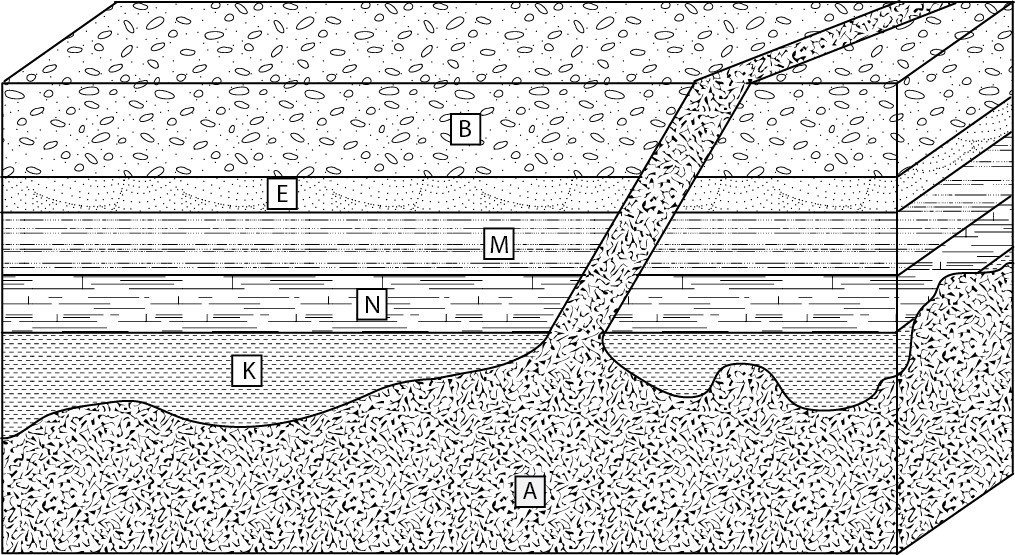
- Referring to the figure above that contains units labeled with letters A, B, E, K, M, and N, list those letters, with the events that produced each unit, in order from oldest to youngest.
- What principle allows us to determine the age relationship between Unit N and Unit A?
- Referring to the second figure in Activity 4.B, with letters A-E, L-O, Q, X, Y and Z, List the events in order from oldest to youngest.
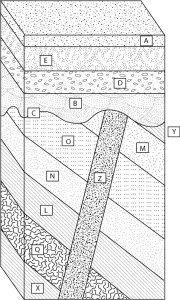
- What principle did you use to determine the age relationship between unit X and unit Q? What about unit B and unit D?
- Indicate the sequence of events for the problem below by adding numbers to the circles as in the example to its left, letting “1” represent the oldest event and “8” the youngest/most recent.
- Write a narrative for the sequence of events you labeled above.

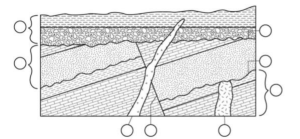
Activity 4.C—Absolute Dating: Radiometric Dating of Rocks (Johnson, 2018)
The blue line and numbers on the y-axis on the graph below shows the % of parent isotopes remaining in a sample. The red line and numbers show the % of daughter isotopes in the sample. The x-axis indicates how many half-lives have passed. The chart below the graph provides the half-lives for some important isotopes.
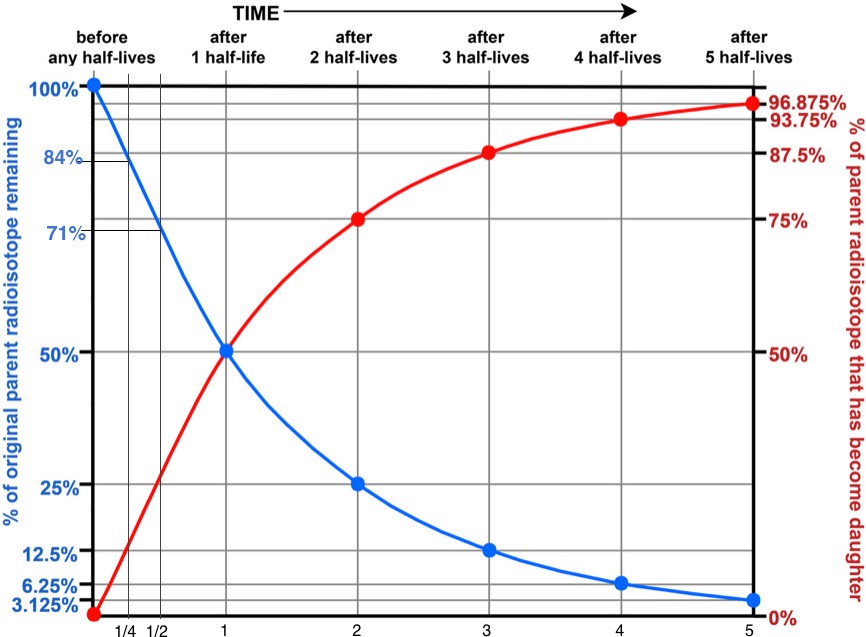
|
Parent Isotope |
Half-Life |
Daughter Isotope |
|
Carbon-14 |
5,730 years |
Nitrogen-14 |
|
Uranium-235 |
713 million years |
Lead-207 |
|
Potassium-40 |
1.3 billion years |
Argon-40 |
|
Uranium-238 |
4.5 billion years |
Lead-206 |
- If your sample of potassium feldspar contains 50% argon-40 and 50% potassium-40, how many half-lives have passed?
- How old is the sample referred to in question 1?
- If your sample contains 75% argon-40 and 25% potassium-40, how many half lives have passed?
- How old is the sample referred to in question 3?
- How old is your sample if it contains 87.5% Argon?
- How old is your sample if it contains 84% Potassium?
- A lava flow containing zircon mineral crystals is exposed in an outcrop in Hawaii. A mass spectrometer analysis showed that 71% of the atoms were Uranium-235 and 29% of the atoms were Lead-207. What is the half-life of Uranium-235?
- What is the daughter atom produced when Uranium-235 decays?
- How many half-lives of the Uranium-235 Lead-207 decay pair have elapsed?
- What is the radiometric age of the lava flow? Show your work.
- Are the layers below the lava flow older or younger than the lava flow?
- Carbon-14 is continuously replaced in living organisms as long as they live. When an organism dies, the Carbon-14 in its body is no longer replaced. Carbon-14 decays to Nitrogen-14, so the amount of Carbon-14 in the dead organism decreases over time. You are coring into a coral reef to see how old it is. Your coral sample reveals that it has 525 parts of Carbon-14 and 3500 parts of Nitrogen-14. What is the percentage of Carbon-14 in the sample?
- How old is the coral sample?
- Layers of sand on a beach in California contain mineral crystals of zircon. Can the zircon crystals be used to date when they were deposited on the beach? Why or why not?
- When sampling from an ancient peat bog, you must be careful not to include any living roots. Why?
- All of the rocky material in the solar system, including the Earth, Mercury, Venus, Mars, and the oldest meteorites were formed about the same time. The oldest meteorites found on earth contain equal amounts of Uranium-238 and Lead-206. How old does this make the Earth?
REFERENCES
Bosch, Rachel F. Zabriskie Point, Death Valley National Park, Sunrise. May 1, 2017. Digital photography.
Johnson, Sarah, 2018, Radiometric Dating, https://nku.instructure.com/courses/15045/pages/geologic-time-and-dating/revisions; last access: 2021-11-27.
Link, Paul, John Welhan, Jim McNamara, Charles Peterson, Stefan Sommer, and Tamra Shiappa. “What Are Stratigraphic Columns?” Digital Atlas of Idaho. Accessed July 19, 2019. https://digitalatlas.cose.isu.edu/geo/basics/sedstrat.htm.
Palmer, Arthur N. “Stratigraphic Column, Mammoth Cave National Park, Kentucky.” 1998.
Steno, Nicolaus. 1669, “The Prodromus of Nicolaus Steno’s Dissertation Concerning a Solid
Body Enclosed By a Process of Nature Within a Solid; English Translation with Notes and
Introduction” by John Garrett Winter, 1916, University of Michigan Humanistic Studies, Vol.
XI, Pt 2.
United States Geologic Survey, 2007, “Age of the Earth,” https://pubs.usgs.gov/gip/geotime/age.html; last access: 2022-07-06.
United States Geologic Survey, 2008, “Spiral Age of the Earth Diagram.” March 25, 2008. https://pubs.usgs.gov/gip/geotime/time.html; last access: 2022-07-06.
